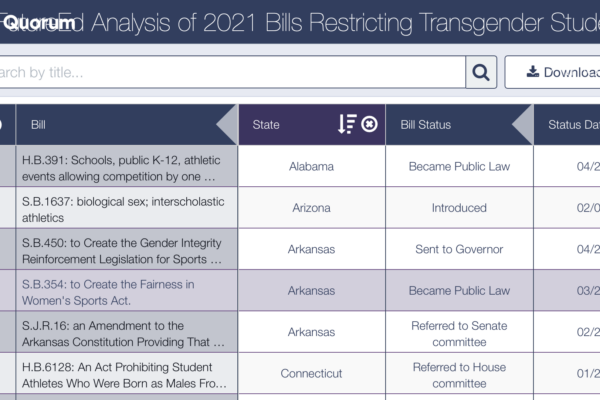Last year, Idaho became the first state to ban transgender student athletes from competing in girls sports, followed by seven more states this year: Alabama, Arkansas, Florida, Mississippi, Montana, Tennessee, and West Virginia. Bills in three states, Kansas, North Dakota, and South Dakota, were vetoed.
Civil rights groups are challenging the Idaho law in federal court, arguing it violates prohibitions against discrimination on the basis of sex in education programming under Title IX of the Education Amendments of 1972 and the equal protection and due process clauses of the 14th Amendment, as well as the unlawful searches and seizures clause of the Fourth Amendment of the U.S. Constitution.
[Read More: What’s Next for Title IX?]
The case comes as Republican state legislators nationwide are seeking such bans. FutureEd has identified 83 pieces of legislation pending in 32 state legislatures that would reduce transgender students’ ability to play school sports on the grounds that it would be unfair to competition for girls, costing them opportunities for top finishes and athletic scholarships. Athletic associations in 15 states and Washington, D.C. currently permit transgender students to play girls’ sports without restrictions, the Center for American Progress reports.
There is little evidence to support the Republican campaign against transgender athletes.
For one thing, there are very few transgender athletes in most states. And restricting their participation does little to protect the rights of other girls, while further marginalizing an already-vulnerable population. Joanna Harper, a research at Loughborough University in Great Britain, estimates that out of 200,000 female U.S. college athletes in a given year, only about 50 are transgender.
At the same time, restrictions on transgender student participation in school sports compound the already daunting social and emotional challenges the students face. A Center for American Progress analysis of the U.S. Centers for Disease Control and Prevention’s 2017-19 Youth Risk Behavior Survey found strikingly high risk of suicide among transgender high school students: 44 percent of transgender respondents reported they had considered suicide in the previous 12 months, compared to 16 percent of other students.
Some states permit transgender students participate in girls’ sports if they have permissible hormone levels. Others require gender-reassignment surgery as a precondition for participation. Hormone standards are common for the Olympics and the National Collegiate Athletic Association. But hormone treatment and gender-reassignment surgery are not always recommended or available for high schoolers.
The spate of proposed legislative prohibitions is discriminatory in another way: Most of the bills would only prohibit transgender students’ participation in girls’ sports. Among the titles of pending legislation: “An Act To Ban Biological Males from Participating in Women’s Sports,” in Maine, and “Save Women’s Sports” acts in Ohio, North Carolina and South Carolina.
As in Idaho, the courts will determine the fate of these laws.
The U.S. District Court of Connecticut recently dismissed on procedural grounds a much-watched challenge to transgender athletes in a Connecticut high school, leaving unresolved key questions about participation in girls’ sports as opposition to transgender athletes grows in state legislatures. The court ruled in Soule et al v. Connecticut Association of Schools et al that the challenge by three Connecticut students was moot because the transgender high school athletes in the case had graduated and that the female athletes who brought the case were unlikely to compete against other transgender students.
But while the court in Soule didn’t rule on the merits of the challenge to transgender students, it noted that Title IX protects transgender student athletes. The three students are appealing the ruling.
In the end, participating in, not winning, athletic competitions provides the biggest benefit to students’ physical and mental well-being, and to their sense of belonging in their school communities. And transgender-inclusive policies help promote those goals among all students.

